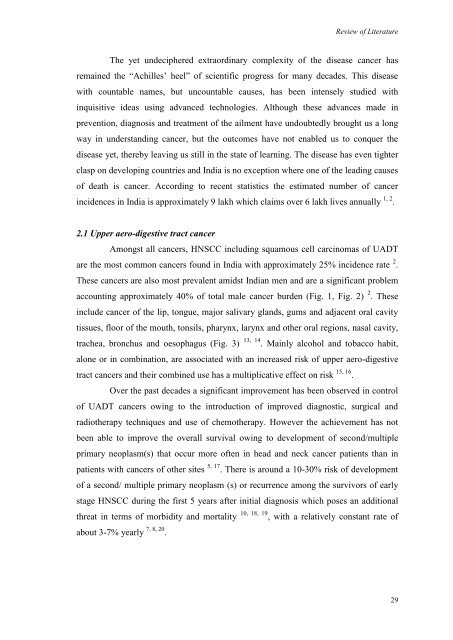LIFE09200604007 Tabish - Homi Bhabha National Institute
LIFE09200604007 Tabish - Homi Bhabha National Institute
LIFE09200604007 Tabish - Homi Bhabha National Institute
You also want an ePaper? Increase the reach of your titles
YUMPU automatically turns print PDFs into web optimized ePapers that Google loves.
Review of Literature<br />
The yet undeciphered extraordinary complexity of the disease cancer has<br />
remained the “Achilles‟ heel” of scientific progress for many decades. This disease<br />
with countable names, but uncountable causes, has been intensely studied with<br />
inquisitive ideas using advanced technologies. Although these advances made in<br />
prevention, diagnosis and treatment of the ailment have undoubtedly brought us a long<br />
way in understanding cancer, but the outcomes have not enabled us to conquer the<br />
disease yet, thereby leaving us still in the state of learning. The disease has even tighter<br />
clasp on developing countries and India is no exception where one of the leading causes<br />
of death is cancer. According to recent statistics the estimated number of cancer<br />
incidences in India is approximately 9 lakh which claims over 6 lakh lives annually 1, 2 .<br />
2.1 Upper aero-digestive tract cancer<br />
Amongst all cancers, HNSCC including squamous cell carcinomas of UADT<br />
are the most common cancers found in India with approximately 25% incidence rate 2 .<br />
These cancers are also most prevalent amidst Indian men and are a significant problem<br />
accounting approximately 40% of total male cancer burden (Fig. 1, Fig. 2) 2 . These<br />
include cancer of the lip, tongue, major salivary glands, gums and adjacent oral cavity<br />
tissues, floor of the mouth, tonsils, pharynx, larynx and other oral regions, nasal cavity,<br />
trachea, bronchus and oesophagus (Fig. 3) 13, 14 . Mainly alcohol and tobacco habit,<br />
alone or in combination, are associated with an increased risk of upper aero-digestive<br />
tract cancers and their combined use has a multiplicative effect on risk 15, 16 .<br />
Over the past decades a significant improvement has been observed in control<br />
of UADT cancers owing to the introduction of improved diagnostic, surgical and<br />
radiotherapy techniques and use of chemotherapy. However the achievement has not<br />
been able to improve the overall survival owing to development of second/multiple<br />
primary neoplasm(s) that occur more often in head and neck cancer patients than in<br />
patients with cancers of other sites 5, 17 . There is around a 10-30% risk of development<br />
of a second/ multiple primary neoplasm (s) or recurrence among the survivors of early<br />
stage HNSCC during the first 5 years after initial diagnosis which poses an additional<br />
threat in terms of morbidity and mortality 10, 18, 19 , with a relatively constant rate of<br />
about 3-7% yearly 7, 8, 20 .<br />
29

















